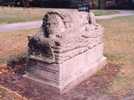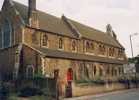For this church:    |
|
 The
monument to “Bendigo” The
monument to “Bendigo” |
The cemetery was opened in 1834 after the cholera outbreak of 1833 that filled the remaining space in St Mary’s other graveyards. Burials ceased in 1902. By the 1960s, the graveyard had become very neglected and was adopted by the City Council, who removed the remaining monuments to the outer walls for greater ease of maintenance. One of the only notable memorials still in its original position is that of William Abednigo Thomson 1811-1880, known as Bendigo, who was the unbeaten English bare fist boxing champion for many years, but ended his life as a well known local preacher. Another memorial, which has survived, is that of the Rev Henry Edwin Daniels, the first vicar of St Luke’s Church which stood on the edge of the parish. He died in 1862 at the age of 32 years. Of the many headstones leaning against the boundary wall, the saddest is perhaps that of Willie Moore who was drowned at the age of 5 in 1870.
It is likely that some graves are located in the old garden areas at the side of the church. Some graves were uncovered and removed during the excavation for the church foundations, but those under the floor were left untouched.
Located outside the boundary wall on the south side of the burial ground is what appears to be the entrance to a crypt. It is against the wall protected by trees and a metal fence, so close inspection is not possible The building is in fair condition, constructed of brick with some decorative stone. A wrought iron gate forms the entrance.






